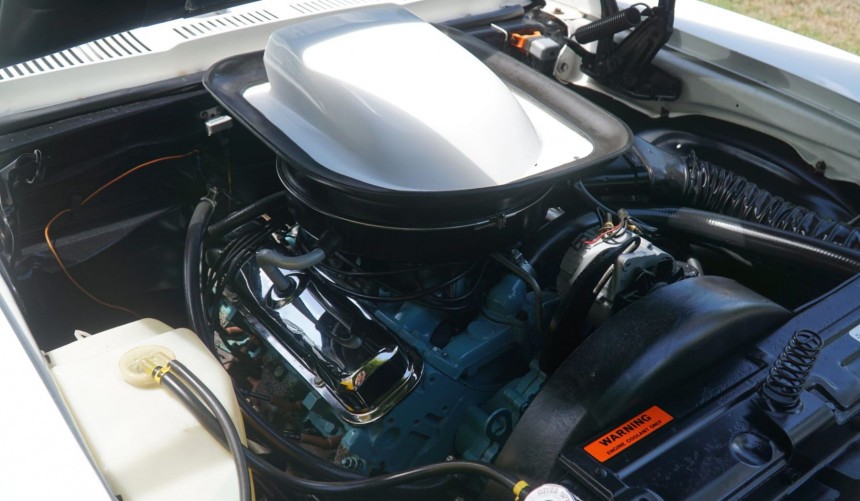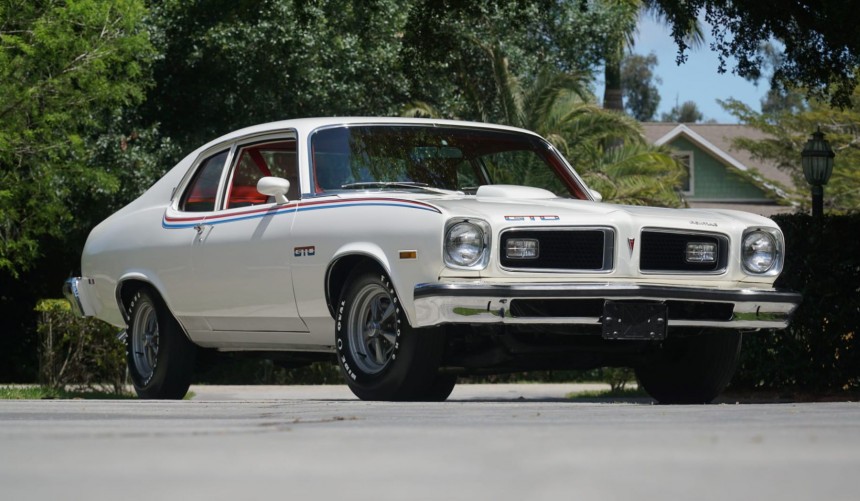Though the legendary GTO nameplate was briefly revived by Pontiac during the mid-2000s as a rebadged Holden Monaro, the last, 100% American version of the GOAT was a Ventura-based compact.
While high-powered, factory-built intermediates existed before 1964, when Pontiac introduced the wildly popular GTO package for its A-body Le Mans, it started arguably the most exciting era of the American automotive industry.
Yes, we call it "the muscle car era," but the truth is that, at its height, that golden age of American factory-built performance lasted less than a decade.
Nevertheless, during that period, the country's biggest automotive brands unleashed an impressive number of thoroughbred muscle cars.
Apart from being credited with kickstarting the muscle car craze, the mighty Pontiac GTO stood at the height of the muscle car food chain for nine consecutive model years and two distinct generations.
By 1973, the curtain fell abruptly on all things muscle due to rising insurance premiums, stringent emission regulations, and a ravaging oil crisis.
Consequently, some of the iconic models that defined the era rode into the sunset, but the GTO managed to survive for two more model years - albeit in two different and controversial guises.
For the 1973 model year, the LeMans and all other GM A-body intermediates were thoroughly redesigned.
To abide by new crash safety regulations, they became longer but also boxier, sporting large bumpers.
For Pontiac, the new safety and emission regulations, combined with the debut of the 1973 oil crisis, meant that the focus shifted from pure high-performance V8-induced excitement to delivering a more premium-oriented intermediate.
Though the new Colonade-style LeMans wasn't as exciting as its predecessors in terms of styling and performance, it was still available with the GTO package.
Though far more subdued and, in the best possible guise, powered by a 250-hp (net) 455-ci (7.5-liter) V8, the new GTO shined when it came to handling, especially when compared to its predecessors. Nevertheless, it never managed to become the sales sensation of old.
In 1974, Pontiac management decided to drop the GTO package from the LeMans lineup, but thanks to Ben Harrison, one of the brand's leading engineers and a lifelong performance enthusiast, the GTO survived for another year.
However, the package was now available for the Ventura (aka Ventura II), the X-body compact cousin of the Chevy Nova.
Naturally, some enthusiasts were (and still are) enraged by this decision, but it turned out to be a smart move that gave birth to one of the most underrated Pontiac muscle cars ever.
Available for both the base Ventura and Ventura Custom in two-door sedan (with a conventional trunk) or hatchback guises, the $461 GTO package (Code WW3) added a hefty list of upgrades.
These included a unique grille, GTO badges, a functional Trans Am-style Shaker hood scoop (unlike the 1973 version), wing mirrors, and a heavy-duty suspension system with front and rear anti-roll bars.
Handling could be refined with the addition of the Radial Tuned Suspension (RTS) package, which added optimized springs and shock valves tuned for use with the new steel-belted radial tires.
Additionally, power steering and power front disc brakes could be optionally fitted to improve the Little GTO's road manners even more.
Unlike previous generations, the Ventura-based GTO was only available with a single engine choice.
The powerplant in question was Pontiac's 350 cu in (5.7-liter) V8, donning a Rochester 4MC Quadrajet carb and a 7.6:1 compression ratio.
Mated to a standard three-speed, Hurst shifter-equipped manual transmission, an optional Saginaw M-20 four-speed manual, or a three-speed Turbo Hydra-Matic automatic (also optional), the small (by 1974 standards) Pontiac V8 could make 200 hp at 4,400 rpm and 295 lb-ft (400 Nm) of torque at 2,800 rpm.
Those figures were much lower than those of the large-displacement Tri-Power GTO engines of the past—and even 50 hp less than the 1973 455—but considering that the compact X-body chassis was about 400 pounds (181.4 kg) lighter than previous A-body intermediates, the Little GTO was a more-than-adequate Malaise Era performance car.
With only 200 net horsepower on tap, the Little GTO seemed to be an insult to a legendary nameplate. However Harrison and the team in charge of the project made sure that wasn't the case.
According to independent tests conducted by the era's most prestigious car magazines, the car (equipped with the optional four-speed) could accelerate to 60 mph (97 kph) from a standstill in 7.7 seconds and run the quarter mile in the high 15-second range.
While that made it sensibly slower than a 1965 Tri-Power, Cars magazine conducted a head-to-head comparison with a 1964 389 four-barrel-powered GTO, and the results were surprisingly close.
The 1974 compact was only 0.2 seconds slower from 0 to 60, while the older model achieved a 15.64-second quarter mile run at 90 mph (144.8 kph). Its smaller sibling ran the same distance in 15.72 seconds at 88 mph (141.6 kph).
Those results made the Little GTO a legitimate muscle car worthy of the nameplate, but the Cars magazine went even further, calling it a far better-handling car than the 1964 legend.
Thanks to its lower weight, shorter wheelbase, and smart suspension tuning, it attacked sharp corners with a level of precision and elegance more comparable to an entry-level Euro sports car than a classic, high-powered American intermediate.
However, other publications were less enthusiastic about the 1974 GTO. Furthermore, while it was adequately fuel-efficient and not that expensive to insure, the car-buying public's appetite for performance had decreased exponentially.
Pontiac only managed to sell 7,058 GTO-equipped Venturas that year, and although that was a sensible improvement compared to the 1973 model, the figure wasn't good enough to convince management to continue marketing the GTO package in 1975.
Half a century later, the Little GTO still struggles to shake off the stigma surrounding it.
For most muscle car enthusiasts, especially those with a soft spot for Pontiacs, it's still an ugly compact that doesn't deserve to wear GTO badges.
However, while the looks are debatable, hating on its performance, or perceived lack thereof, is unfair.
When it was introduced, the 1974 GTO was unquestionably a capable performance-oriented compact that could hold its own in a straight line but also deliver a thrilling driving experience on a winding road.
In terms of collectibility, it's far cheaper than its older siblings, with pristine, optioned-out examples going for around $30,000.
You can take a virtual tour of one in the YouTube video below by Lou Costabile.
Yes, we call it "the muscle car era," but the truth is that, at its height, that golden age of American factory-built performance lasted less than a decade.
Nevertheless, during that period, the country's biggest automotive brands unleashed an impressive number of thoroughbred muscle cars.
Apart from being credited with kickstarting the muscle car craze, the mighty Pontiac GTO stood at the height of the muscle car food chain for nine consecutive model years and two distinct generations.
By 1973, the curtain fell abruptly on all things muscle due to rising insurance premiums, stringent emission regulations, and a ravaging oil crisis.
Consequently, some of the iconic models that defined the era rode into the sunset, but the GTO managed to survive for two more model years - albeit in two different and controversial guises.
From Colonade intermediate to full-blown compact
To abide by new crash safety regulations, they became longer but also boxier, sporting large bumpers.
For Pontiac, the new safety and emission regulations, combined with the debut of the 1973 oil crisis, meant that the focus shifted from pure high-performance V8-induced excitement to delivering a more premium-oriented intermediate.
Though the new Colonade-style LeMans wasn't as exciting as its predecessors in terms of styling and performance, it was still available with the GTO package.
Though far more subdued and, in the best possible guise, powered by a 250-hp (net) 455-ci (7.5-liter) V8, the new GTO shined when it came to handling, especially when compared to its predecessors. Nevertheless, it never managed to become the sales sensation of old.
In 1974, Pontiac management decided to drop the GTO package from the LeMans lineup, but thanks to Ben Harrison, one of the brand's leading engineers and a lifelong performance enthusiast, the GTO survived for another year.
However, the package was now available for the Ventura (aka Ventura II), the X-body compact cousin of the Chevy Nova.
The Little GTO
Available for both the base Ventura and Ventura Custom in two-door sedan (with a conventional trunk) or hatchback guises, the $461 GTO package (Code WW3) added a hefty list of upgrades.
These included a unique grille, GTO badges, a functional Trans Am-style Shaker hood scoop (unlike the 1973 version), wing mirrors, and a heavy-duty suspension system with front and rear anti-roll bars.
Handling could be refined with the addition of the Radial Tuned Suspension (RTS) package, which added optimized springs and shock valves tuned for use with the new steel-belted radial tires.
Additionally, power steering and power front disc brakes could be optionally fitted to improve the Little GTO's road manners even more.
A single engine option
The powerplant in question was Pontiac's 350 cu in (5.7-liter) V8, donning a Rochester 4MC Quadrajet carb and a 7.6:1 compression ratio.
Mated to a standard three-speed, Hurst shifter-equipped manual transmission, an optional Saginaw M-20 four-speed manual, or a three-speed Turbo Hydra-Matic automatic (also optional), the small (by 1974 standards) Pontiac V8 could make 200 hp at 4,400 rpm and 295 lb-ft (400 Nm) of torque at 2,800 rpm.
Those figures were much lower than those of the large-displacement Tri-Power GTO engines of the past—and even 50 hp less than the 1973 455—but considering that the compact X-body chassis was about 400 pounds (181.4 kg) lighter than previous A-body intermediates, the Little GTO was a more-than-adequate Malaise Era performance car.
A legitimate muscle car
According to independent tests conducted by the era's most prestigious car magazines, the car (equipped with the optional four-speed) could accelerate to 60 mph (97 kph) from a standstill in 7.7 seconds and run the quarter mile in the high 15-second range.
While that made it sensibly slower than a 1965 Tri-Power, Cars magazine conducted a head-to-head comparison with a 1964 389 four-barrel-powered GTO, and the results were surprisingly close.
The 1974 compact was only 0.2 seconds slower from 0 to 60, while the older model achieved a 15.64-second quarter mile run at 90 mph (144.8 kph). Its smaller sibling ran the same distance in 15.72 seconds at 88 mph (141.6 kph).
Those results made the Little GTO a legitimate muscle car worthy of the nameplate, but the Cars magazine went even further, calling it a far better-handling car than the 1964 legend.
Thanks to its lower weight, shorter wheelbase, and smart suspension tuning, it attacked sharp corners with a level of precision and elegance more comparable to an entry-level Euro sports car than a classic, high-powered American intermediate.
However, other publications were less enthusiastic about the 1974 GTO. Furthermore, while it was adequately fuel-efficient and not that expensive to insure, the car-buying public's appetite for performance had decreased exponentially.
Pontiac only managed to sell 7,058 GTO-equipped Venturas that year, and although that was a sensible improvement compared to the 1973 model, the figure wasn't good enough to convince management to continue marketing the GTO package in 1975.
The 1974 GTO today
For most muscle car enthusiasts, especially those with a soft spot for Pontiacs, it's still an ugly compact that doesn't deserve to wear GTO badges.
However, while the looks are debatable, hating on its performance, or perceived lack thereof, is unfair.
When it was introduced, the 1974 GTO was unquestionably a capable performance-oriented compact that could hold its own in a straight line but also deliver a thrilling driving experience on a winding road.
In terms of collectibility, it's far cheaper than its older siblings, with pristine, optioned-out examples going for around $30,000.
You can take a virtual tour of one in the YouTube video below by Lou Costabile.
















